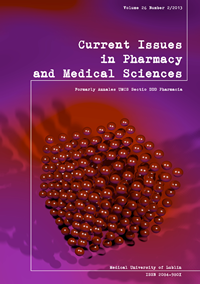Mechanisms of interaction of acetaminophen metabolites in terms of hepatotoxicity
DOI:
https://doi.org/10.12923/j.2084-980X/26.2/a.19Słowa kluczowe:
acetaminophen, covalent modification of proteins, cytochrome P-450, hepatotoxicityAbstrakt
The most serious complication after ingestion of a toxic dose of acetaminophen is liver damage. The aim of study was to review the research on the biochemical and molecular mechanisms of acetaminophen hepatotoxicity. It was shown that effect of the acetaminophen metabolism is the production of N-acetyl-p-benzoquinone, which is formed by bioactivation with the participation of cytochrome P450 enzymes. The combination of N-acetyl-p-benzoquinone and proteins can cause a disruption in protein homeostasis in cell membrane and mitochondrion. It may interfere with cellular signal process. Small and chronic doses of acetaminophen lead to damage of the cell nucleus. These effects can explain the mechanism of hepatotoxicity. N-acetyl-pbenzoquinone can cause an increase in oxidative stress. Lipids peroxidation and proteins oxidation are the main factors, which lead to necrosis of hepatocytes. It was shown that N-acetyl-p-benzoquinone can cause a decrease in GSH level and SH groups. For this reason, N-acetyl-p-benzoquinone was recognized as a key factor of the acetaminophen hepatotoxicity.
Bibliografia
1. Bessems J.G.M., Vermeulen N.P.E.: Paracetamol (Acetaminophen) – induced toxicity: molekular and biochemical mechanisms, analogues and protective approaches. Crit. Rev. Toxicol., 31, 55-138, 2001.
2. Chandrasekharan N.V. et al.: COX-3, a cyclooxygenase-1 variant inhibited by acetaminophen and other analgesic/antipyretic drugs: Cloning, structure, and expression. Proc. Natl. Acad. Sci., 99, 13926-13931, 2002.
3. Chun L.J. et al.: Acetaminophen hepatotoxicity and acute liver failure. J. Clin. Gastroenterol., 43, 342-349, 2009.
4. Dargan PI., Jones AL.: Acetaminophen poisoning: an update for the intensivist. Crit. Care, 6, 108-110, 2002.
5. Henderson N.C. et al.: Critical role of c-jun (NH2) terminal kinase in paracetamol induced acute liver failure. Gut., 56, 982–990, 2007.
6. Hinson J.A., Roberts D.W., James L.P.: Mechanisms of acetaminophen-induced liver necrosis. Handb. Exp. Pharmacol., 196, 369–405, 2010.
7. James L.P., Mayeux P.R., Hinson J.: Acetaminophen – induced hepatotoxicity. Drug Metab. Dispos., 31, 1499-1506, 2003.
8. Ji P., et al.: Regulatory review of acetaminophen clinical pharmacology in young pediatric patients. J. Pharm. Sci.101, 4383-4389, 2012.
9. Kaplovitz N: Acetaminophen hepatotoxicity: What we know, what don’t know, and what we do next? Hepatology, 40, 24-26, 2004.
10. Katzung B., Master S., Trevor A.: Basic and Clinical Pharmacology, 11th Edition. Internet:_http://156.17.60.61/han/AccessMedicine/www.accessmedicine.com/popup.aspx?aID=4515781&searchStr=acetaminophen (accessed 12 April 2011).
11. Kaushal R., Kunjan R., Katyare S.S.: Paracetamol hepatotoxicity and microsomal function. Eur. J. Pharmacol., 7, 67-74, 1999.
12. Kurpas D., Steciwko A.: Paracetamol i ibuprofen w codziennej praktyce lekarza rodzinnego, Terapia, 2009, 17, 107-112.
13. Randall B.G.: Acetaminophen protein adducts: A review. Clin. Toxicol., 47, 2-7, 2009.
14. Toussaint K. et al.: What do we (not) know about how paracetamol (acetaminophen) works? J. Clin. Pharm. Ther., 35, 617-638, 2010.
15. Wallace J.L.: Acetaminophen hepatotoxicity: NO to the rescue. Br. J. Pharmacol., 143, 1-2, 2004.
Pobrania
Opublikowane
Numer
Dział
Licencja
Prawa autorskie (c) 2013 Autorzy

Praca jest udostępniana na licencji Creative Commons Attribution-NonCommercial-NoDerivatives 3.0 Unported License.


